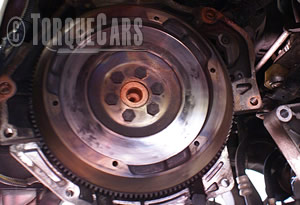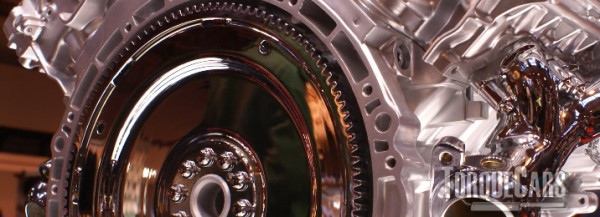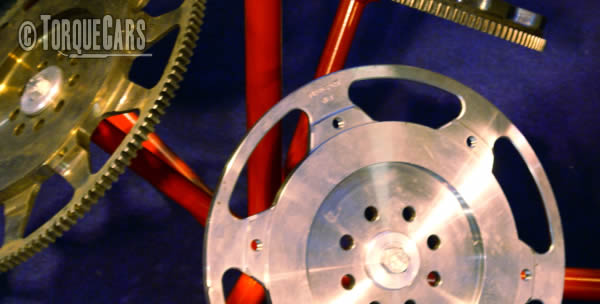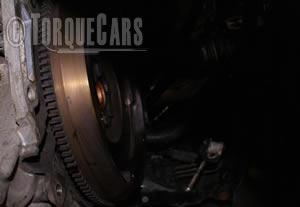Is switching from a DMF to solid flywheel worth it?
"DMF or SMF which one is right for you?"

Which one is better and what are the pros and cons of conversion?
Why do manufactures install what appears to be an expensive and potentially unreliable dual mass Flywhee (DMF)?
What are DMF flywheels and why do people convert to solid ones?
The flywheel in a car helps to maintain the rotational energy from the engine.
This helps to avoid stalling and bogging down and makes it a lot easier to keep a car engine at constant RPM which is great for everyday driving and cruising.
So what is a flywheel?
Think of it as a buffer or reservoir. Without a flywheel every single fluctuation from the engine would be noticed. The gearbox and clutch would suffer from these shock waves, and the car would lose speed really quickly when you lift off throttle.

What is a DMF or dual mass flywheel?
Firstly a DMF has two sections sprung together. The inner one connects to the engine and the outer one connects to the inner one by means of a flexible sprung connection allowing it to move slightly independently of the inner flywheel so it rotates with a slight delay smoothing things out considerably.
If there is a power blip or 'burp' from the engine the inner flywheel feels this directly but the outer flywheel can move independently to the inner one (within limited confines) and helps to smooth these little blips.
The big benefit of a DMF is that the engine feels incredily smooth. The power fluctuations are smoothed out or dampened down lessening the wear and tear on the transmission and clutch.
Most manufacturers recommend changing the DMF at the same time as the clutch. Since clutch replacement usually requires removal of the flywheel it makes sense to do both at the same time. DMF are subject to wear and if the sprung link goes will seriously hamper the smooth running nature of the engine.
Benefits of solid flywheels
The DMF is usually more expensive than a solid flywheel and due to complexity has more opportunity to go wrong.
They do not break up when they fail. They are more suited to conditions where frequent engine speed changes and gear changes are made.

Benefits of DMF
They smooth out the engine causing it to feel silky smooth and this reduces wear on other parts of the transmission.
You really do need this in a diesel engine as they are quite rough running compared to a petrol engine. In smooth petrol engines they are nice to have. A DMF will also protect an engine as well as the gearbox from shock and vibration.
Should you convert a DMF with a solid flywheel?
It is our considered opinion that unless a car is used extensively for competition or off road you should stick with a DMF. The additional torque caused by tuning an engine or heavy competition use can quickly destroy a DMF. The solution would be to fit a stronger, higher performance DMF but the aftermarket industry seems geared up to offer solid ones as the upgrade option.
A solid flywheel replacement is often regretted by it's owner. They list vibrations and extra noise as the main issues. Gear changes appear to be required more frequently especially on hills.
It is tempting to fit a lighter flywheel for performance reasons. A full discussion of the merits of lighter flywheels can be found here, but, unless you have a serious need for a solid flywheel, TorqueCars recommends you stick with an OEM spec DMF one.
If you have a 6 cylinder engine that is particularly smooth then a DMF seems to be a luxury you can safely drop.

There are plenty of reports out there of drivers and our members who have happily replaced a DMF with a solid flywheel.
They will generally concede that there is no advantage to having a solid flywheel though in terms of performance, so the only consideration is cost.
You should also bear in mind the possible future cost of transmission failure as a result of the additional vibrations on other components.
If you do fit a solid flywheel you can help reduce some of the vibrations by fitting a carbon fibre drive shaft. Carbon fibre rotationally flexes absorbing some of the torque and shock from engine speed changes and will help dampen things down a little.
People think lighter flywheels are always better than heavy ones, in reality this depends very much on the use and conditions the car will be asked to perform in. Both have advantages and disadvantages. We find it hard to justify switching from a DMF to an SMF because of the additional risks of complications and the lack of a performance benefit other than the obvious lower cost.
Please Check out my YouTube channel, we're regularly adding new content...
PLEASE HELP: I NEED YOUR DONATIONS TO COVER THE COSTS OF RUNNING THIS SITE AND KEEP IT RUNNING. I do not charge you to access this website and it saves most TorqueCars readers $100's each year - but we are NON PROFIT and not even covering our costs. To keep us running PLEASE Donate here
If you liked this page please share it with your friends, drop a link to it in your favourite forum or use the bookmarking options to save it to your social media profile.
Feedback - What do You Think?
Please use our forums if you wish to ask a tuning question, and please note we do not sell parts or services, we are just an online magazine.
Help us improve, leave a suggestion or tip
Please watch this video and subscribe to my YouTube channel.

 Click to accept YouTube Cookies & Play.
Click to accept YouTube Cookies & Play.